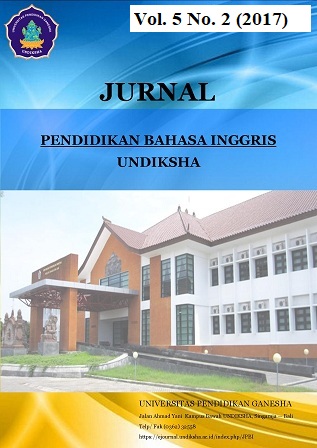The Lingusitic Evidences that Unite Perean and Taro Dialect: A Comparative Study
DOI:
https://doi.org/10.23887/jpbi.v5i2.12123Abstract
Penelitian ini bertujuan untuk menjelaskan persamaan fonologis dan leksikal antara dialek Perean dan dialek Taro. Penelitian ini didesain dalam bentuk penelitian deskriptif kualitatif dengan karakteristik sinkronis. Data yang telah diperoleh dalam bentuk kata diidentifikasi dengan menggunakan daftar kata Swadesh, daftar kata Nothofer, dan daftar kata Holle. Data didapatkan dengan menggunakan teknik observasi, rekaman, dan catatan. Dalam mengumpulkan data, dipilih tiga narasumber pada setiap dialek. Hasil dari penelitin ini menunjukan bahwa ada 46 fonem yang telah dibuktikan sama di antara kedua dialek. Mereka adalah: 1) enam vokal /ʌ/,/i/,/u/,/ɛ/,/ɒ/, and /ə/; 2) delapan diftong /ʌɪ/, /ʌu/, /ʌɛ/, /ʌɒ/, /ɪʌ/, /ɪu/, /uʌ/, and /ʊʌ/; 3) lima geminates /ʌʌ/, /ɪɪ/, /ʊʊ/, /ɒɒ/, and /əə/; 4) sembilan belas konsonan /p/, /b/, /t/, /d/, /k/, /g/, /ʔ/, /s/, /c/, /j/, /l/, /h/, /m/, /n/, / ñ /, /ŋ/, /r/, /w/, and /y/; and 5) delapan konsonan kluster /kl/, /bl/, /ml/, /kr/, /pr/, /mp/, /mb/, dan /ŋkKata Kunci : diftong, fonologi, geminate, kata, konsonan, konsonan kluster, Perean Dialek, Taro Dialek, vokal.
This research aimed at describing the phonological and lexical similarities between Perean Dialect and Taro Dialect. This research was designed in the form of descriptive qualitative study which has synchronic characteristics. The obtained data was in the forms of lexicon identified by using Swadesh’s, Nothofer’s, and Holle’s Wordlist. The data were collected through observation, recording, and note taking techniques. The sources of data were three informants from each dialect were selected by using a set of criteria. The results of this research show that there are 46 phonemes have been proven the same from both dialects. They are: 1) six vowels /ʌ/,/i/,/u/,/ɛ/,/ɒ/, and /ə/; 2) eight diphthongs /ʌɪ/, /ʌu/, /ʌɛ/, /ʌɒ/, /ɪʌ/, /ɪu/, /uʌ/, and /ʊʌ/; 3) five geminates /ʌʌ/, /ɪɪ/, /ʊʊ/, /ɒɒ/, and /əə/; 4) nineteen consonants /p/, /b/, /t/, /d/, /k/, /g/, /ʔ/, /s/, /c/, /j/, /l/, /h/, /m/, /n/, / ñ /, /ŋ/, /r/, /w/, and /y/; and 5) eight consonant clusters /kl/, /bl/, /ml/, /kr/, /pr/, /mp/, /mb/, and /ŋk/. From the three wordlists, this research found that there are 1297 words which were exactly the same and 181 words which were similar from both Perean Dialect and Taro Dialect.
keyword : consonants, consonant clusters, diphthong, geminate, lexicon, Perean Dialect, phonology, Taro Dialect, vowels.
Published
2017-10-25
Issue
Section
Articles
License
Authors who publish with the Jurnal Pendidikan Bahasa Inggris Undiksha agree to the following terms:- Authors retain copyright and grant the journal the right of first publication with the work simultaneously licensed under a Creative Commons Attribution License (CC BY-SA 4.0) that allows others to share the work with an acknowledgment of the work's authorship and initial publication in this journal
- Authors are able to enter into separate, additional contractual arrangements for the non-exclusive distribution of the journal's published version of the work (e.g., post it to an institutional repository or publish it in a book), with an acknowledgment of its initial publication in this journal.
- Authors are permitted and encouraged to post their work online (e.g., in institutional repositories or on their website) prior to and during the submission process, as it can lead to productive exchanges, as well as earlier and greater citation of published work. (See The Effect of Open Access)













